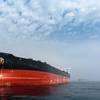Long-Range Clean Tanker Rates Hit 8-Month High
Long-range clean tanker rates stayed firm on Monday extending a recent rally with firmer cargo demand bolstering sentiment further.
Long Range 1 tankers, carrying 55,000 tonne loads from the Middle East Gulf (MEG) to Japan, reached W117.50 in the Worldscale measure, or $11,453 a day when translated into average earnings, the highest since mid September last year.
That compared with W116.14 or $11,156 a day on Friday and W107.45 or $8,112 a day last Monday.
"With plenty of cargoes in the market and tonnage looking fairly thin far out, rates look likely to remain firm for the remainder of May," broker EA Gibson said.
Larger Long Range 2 or LR2, 75,000 tonne shipments on the Middle East Gulf to Japan route were at W101.15 or $14,650 a day, the highest since mid October last year.
That compared with W100.20 or $14,403 a day on Friday and W93.20 or $11,216 a day last Monday.
"Available LR1 tonnage in the Middle East Gulf has been incredibly tight," broker SSY said separately. "Enquiry going forward looks healthy and with LR2s looking steady/firm rates could improve further."
In contrast, rates for medium-range (MR) tankers for 37,000 tonne cargoes on the TC2 route from Rotterdam to New York slipped to W95.00, or $1,986 a day.
That compared with W97.29 or $2,431 a day on Friday and W100.42 or $3,228 last Monday.
"Excess tonnage availability has been one of the main factors behind this weakness in the MR market," EA Gibson said.
In January, earnings reached their highest level since early August last year.
Rates for MR tankers on the U.S. Gulf (USG) to Europe route were negative at W70.00 or -$3,237 a day. That compared with W70.00 or -$3,297 a day on Friday and W72.14 or -$2,674 a day last Monday.
In November last year, rates on that route rose to their highest level since earnings were published in June 2012, Baltic Exchange data showed. Buoyant demand for diesel products has boosted tanker activity on the U.S. Gulf to Europe route, known as the backhaul journey as vessels usually travel to the U.S. East Coast first and then pick up return cargoes.
Average earnings per day are calculated after a vessel covers its voyage costs such as bunker fuel and port fees.
(Reporting by Jonathan Saul; Editing by Mark Potter)










